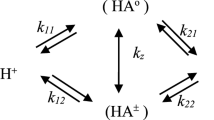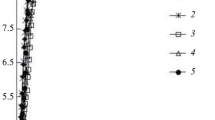Abstract
The 1∶1 complexes of H2O with 1.4-dioxane (as an example of a weak base) and triethylamine (Et 3N) (as an example of a strong base) have been investigated in dilute solutions of non-polar solvents (CCl4, benzene). Compared with the H2O:Et 3N complex, the complex H2O: dioxane has a smaller complex formation constant, a smaller frequency shift of the OH fundamental, and the change of the chemical shift of the OH proton due to complex formation is less pronounced. The volume contraction of mixing in the system H2O+dioxane is also smaller than in the system H2O+Et 3N. On the other hand, in dilute solutions of H2O in dioxane a H2O: (dioxane)2 complex is formed in which both water protons are involved in H-bonds to a dioxane molecule, whereas in dilute solutions of H2O inEt 3N only the 1∶1 complex exists. This behaviour can be explained by the difference in polarity of the 1∶1 complexes. The H2O: dioxane does not show an increment of the dipole moment, but the H2O:Et 3N complex shows an increment of ca. 0.4 D, due to the polarization of the O−H...N bond. This polarization of the H2O-molecule hinders the formation of a second H-bond.
Zusammenfassung
Die 1∶1-Komplexe von H2O mit Dioxan (als Beispiel einer schwachen Base) und Triäthylamin (Et 3N) (als Beispiel einer starken Base) werden in verd. Lösung in nichtpolaren Lösungsmitteln (CCl4, Benzol) untersucht. Wie erwartet, ist im Vergleich zu H2O:Et 3N die Komplexbildungskonstante von H2O: Dioxan kleiner, die Frequenzverschiebung der OH-Fundamentalschwingung geringer und die Veränderung der chemischen Verschiebung des OH-Protons schwächer ausgeprägt. Auch ist die Volumenkontraktion im System H2O+Dioxan weniger bedeutend als im System H2O+Et 3N. Andererseits vermag H2O in verd. Lösungen in Dioxan beide H-Atome unter H-Brückenbildung zu einem 2 Dioxan: 1 H2O-Komplex zu betätigen, während H2O in verd. Lösungen inEt 3N lediglich den 1∶1-Komplex ergibt. Dieses Verhalten kann erklärt werden durch die unterschiedliche Polarität der 1∶1-Komplexe. Während der H2O: Dioxan-Komplex keine Erhöhung des Dipolmoments erkennen läßt, weist der H2O:Et 3N-Komplex infolge der Polarisierung der O−H...N-Bindung ein Inkrement des Momentes von ca. 0,4 D auf. Durch diese zusätzliche Polarisierung des H2O-Moleküls wird die Ausbildung einer zweiten H-Bindung gehemmt.
Similar content being viewed by others

Literatur
S. C. Mohr, W. D. Wilk undG. M. Barrow, J. Amer. Chem. Soc.87, 3048 (1965).
H. E. Affsprung, J. Derkosch undF. Kohler, Discuss. Farad. Soc.40, 224 (1965).
E. Greinacher, W. Lüttke undR. Mecke, Z. Elektrochem.59, 23 (1955).
M. D. Gregory, S. D. Christian undH. E. Affsprung, J. Physic. Chem.71, 2283 (1967).
N. Muller undP. Simon, J. Physic. Chem.71, 568 (1967).
J. R. Johnson, S. D. Christian undH. E. Affsprung, J. Chem. Soc. [London]A 1966, 77.
F. Kohler, Mh. Chem.82, 913 (1951).
E. Tommila undA. Koivisto, Suomen Kemistil.B 21, 18 (1948).
S. D. Christian, H. E. Affsprung, J. R. Johnson undJ. D. Worley, J. Chem. Educ.10, 419 (1963).
C. J. F. Böttcher, Theory of Electric Polarisation, Amsterdam: Elsevier. 1952;T. G. Scholte, Thesis Leiden 1950.
M. D. Gregory, S. D. Christian undH. E. Affsprung, J. Physic. Chem.72, 1748 (1968).
Wegen Einzelheiten vgl.R. Schano, Dissertation Univ. Wien 1969.
G. H. Findenegg undF. Kohler, Trans. Farad. Soc.63, 870 (1967);F. Kohler undE. Rott, Mh. Chem.85, 703 (1954).
Author information
Authors and Affiliations
Additional information
Herrn Univ.-Prof. Dr.O. Kratky gewidmet.
Mit 8 Abbildungen
Rights and permissions
About this article
Cite this article
Schano, R., Affsprung, H.E. & Kohler, F. Der unterschiedliche Charakter von Wasserstoffbindungen in Komplexen zwischen Wasser und organischen Basen. Monatshefte für Chemie 104, 389–401 (1973). https://doi.org/10.1007/BF00903103
Received:
Issue Date:
DOI: https://doi.org/10.1007/BF00903103



